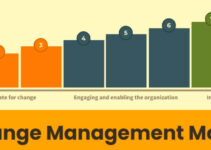Businesses and companies implement radical changes to improve their productivity and gain a competitive edge. The change volume and complexity would increase if multiple change projects are succeeding. However, when a change initiative fails, there are multiple factors contributing to the failure like internal resistance, power dynamics, people aspect of change, and others. Today, we’ll discuss the barriers to change management; and how to overcome the barriers to organizational change.
Barriers to Change Management
Let’s discuss the top barriers to change management; they’re as follows;
Limited Clarity
Organizational change is a difficult and complicated process if it has an unclear vision. It means that you don’t know your existing state and you don’t know how to reach your desired future state. In case of lack of clarity in vision, the change executing team won’t have clarity and it derail the entire change project. If you have a clear change scope and a compelling narrative, then it results in the form of a smooth transition.
Unclear Communication
Ineffective and unclear change communication is the main resistance and barrier to the change project within the organization. It negatively impacts the employee’s engagement, acceptance, and comprehension of the change project. According to an estimate, only 68% of managers and supervisors are aware of the organizational change initiative. Gartner’s study showed that unclear and ineffective communication would cause a high level of stress among 73% of the employees.
Instead of making general announcements for the change project and expecting them to adjust to the organizational changes; they should go for open dialogue and two-way communication and listening to the concerns of employees.
Mistakes in Strategy
If you are developing a clear strategy for the change project, then it has clear goals and objectives and the right allocation of resources. The vague and unclear strategic approach would misguide and mislead the company’s efforts. The company is not utilizing the resources at the optimum level due to ineffective and inefficient communication, and then it results in the form of negative impact and bad results.
Culture of Change Resistance
If the current system has been prevailing for a very long time, employees have become accustomed to the existing status quo culture. When you are changing the long-prevailing system, then you will experience the following issues;
- Internal politics and grouping of employees
- Poor behavioral control
- Personal agenda starting from the surface
- Promote and support the change-resisting culture
- Question and critical of the benefits of the change program
- Lower engagement with the change initiative and oppose the planned changes
Limited Adoption of Organizations
The successful change initiative would start at the top of the organization and then move down to the bottom. The top management and leadership should be on board for the change project to lead the organizational changes. However, it is much more than sponsoring the change project, rather leading the change initiative with example. Employees would feel the value and necessity of the change project, it boosts their morale and confidence level when their leadership is on board with them.
Change Fatigue
Businesses and companies implement multiple changes at one time. When you implement changes, then it creates a lot of uncertainty and confusion among them and it makes them feel overwhelmed. However, it results in the form of change fatigue; the change fatigue would outline frustration, apathy, and burnout. It decreases the employees’ productivity and performance at the workplace.
Limited Management & Governance
Launching the change initiative is highly expensive and the barriers to the change project would increase the expenses. While implementing the changes, you should carefully manage the resources both at the macro and micro level. You can easily scale the change project of various sizes and complexity; it ranges from operational to transformational.
No Support and Training
Lack of support and training for employees’ skill development would lead to errors, mistakes, and delays, and jeopardize the company’s productivity. The inadequate training would decrease the employees’ interest and engagement in the change program, potential disruptions in daily operations, and high reliance on organizational support.
Unrealistic Expectations
Ambitious goals and objectives put a lot of pressure on employees and team members and they result in the form of unrealistic expectations from them. When you are working on a strict deadline, there is no time for planning, training, and adjustment for a successful smooth transition. A high work-pressure environment would decrease employees’ morale and burnout, and they feel overwhelmed by the high expectations.
Leadership Not Onboard
Leadership plays a key role in launching, executing, driving, and sustaining organizational changes. In the absence of a leadership role, you won’t find clarity in vision, credibility, and accountability. Poor leadership means that they have limited knowledge, skills, and expertise to lead and guide the team.
How to Overcome the Barriers to Organizational Change
Some of the main tips and suggestions on how to overcome the barriers to organizational change management are as follows;
- Developing a strategic change approach with the ADKAR model comprising various steps; awareness, desire, knowledge, ability, and reinforcement
- Creating a solid communication plan with clarity and specific goals and objectives by leaving no room for errors
- Involving most affected employees in the change planning process
- Conducting training programs for the new software or system to make the transition phase easier
- Prioritizing the change steps and recognizing the ones that would bring the most benefits
- Recognizing the potential gaps, risks, and limitations in the existing processes
- Connecting and engaging with employees and team members to develop their better comprehension of the change project
- Allowing employees and team members to have sufficient necessary tools, assistance, and resources
- Offering training and support to improve their skills and expertise to comprehend and execute the new methods and processes in a better way
- Measuring and evaluating the success of sustaining the changes in the long term
Conclusion: Barriers to Organizational Change & How to Overcome Them
After an in-depth study of the barriers to change management; we have realized that resistance to the change project isn’t good for growth and success. If you are learning about the barriers to organizational change and how to overcome them; then you should keep in mind the abovementioned potential barriers, and tips to overcome them.
Ahsan is an accomplished researcher and has a deep insight in worldly life affairs. He goes Live 3 days a week on various social media platforms. Other than research writing, he’s a very interesting person.


